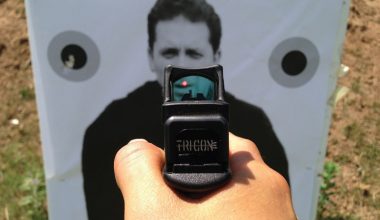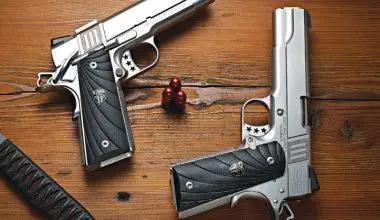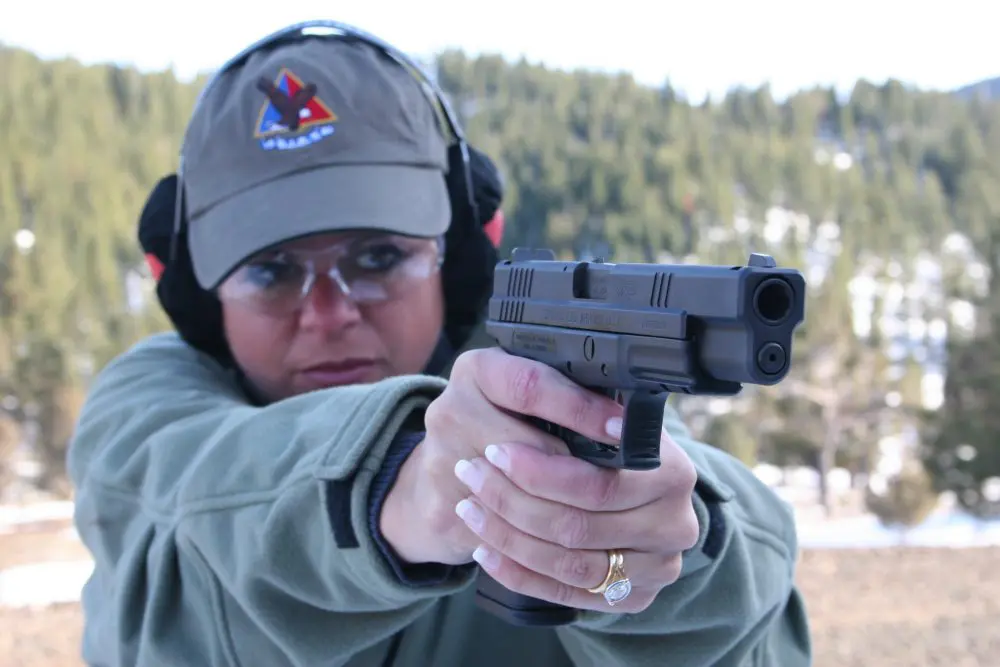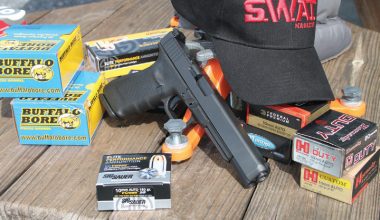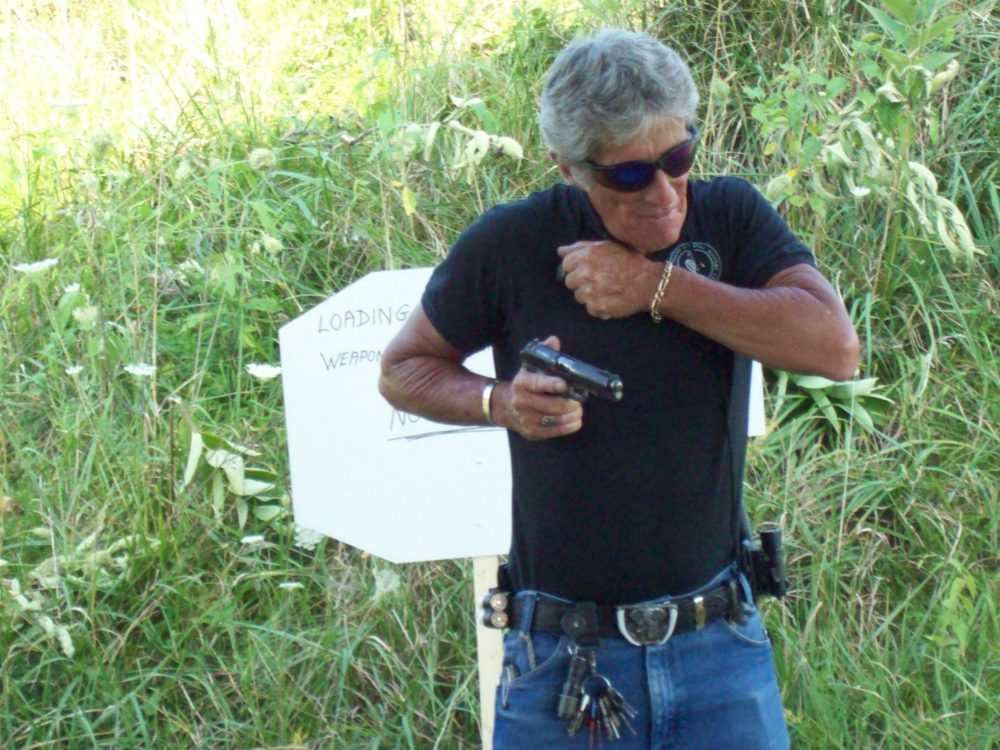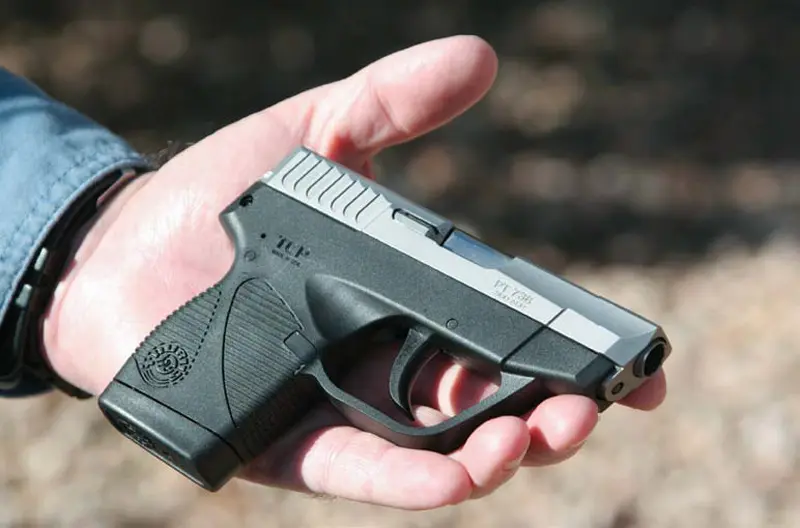
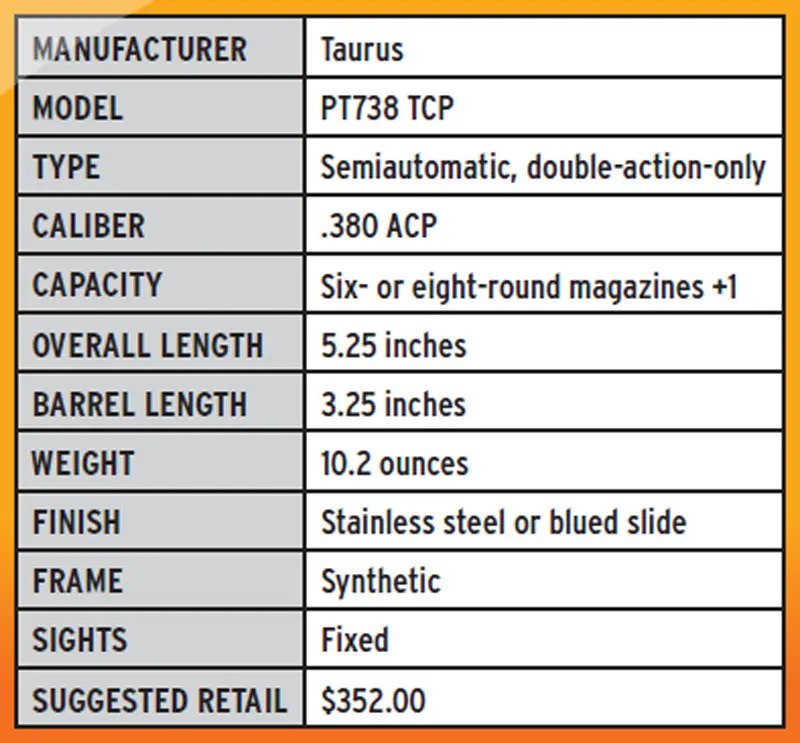
So great is the market for these small guns that suppliers are having a difficult time keeping them and the ammunition for them on the shelf.
Now another major firearms manufacturer has jumped into this market, and with a gun that is going to give all the others some serious competition. Taurus has been producing guns since 1941, so it knows a little about the business, and it shows with the PT738 TCP. TCP stands for Taurus Compact Pistol, and compact it is at only .75 inches wide, 3.7 inches high, 5.9 inches long and 10.2 ounces in weight.
As of this writing, the TCP hasn’t been in the hands of consumers very long. Consequently, I haven’t heard any reports of law enforcement officers selecting the gun as a back-up piece, but it is likely that some will as availability improves.
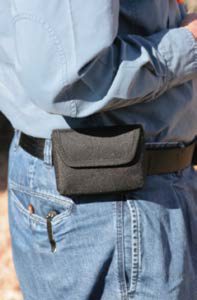
Table of Contents
POCKET PISTOL PLUSES AND MINUSES
Many scoff at the .380 as a self-defense round, and it is certainly not the first choice of most self-defense experts, but some of those same experts carry such a gun for back-up or in other circumstances where a larger gun is not feasible for concealment. Great improvements have been made in the terminal ballistics of .380 ACP projectiles, so they are now better fight stoppers than they once were. Interestingly, the .36-caliber 1851 Navy black powder revolver has about the same ballistics as the .380 ACP FMJ, and Wild Bill Hickok used one very successfully against a number of aggressors.
The real appeal of the TCP, though, is its extremely small size, which lends itself well to deep concealment. It can be secreted away without causing bulges in clothing that might draw attention and, because of its weight, it’s easy to carry. But there are trade-offs. Deep concealment usually means the gun is much slower to put into action, so extra practice is needed to draw the gun efficiently.
Additionally, small guns with diminutive grips are harder to control in recoil than larger guns with bigger handles. Short-barreled guns also have a short sight radius, making them harder to aim, so a gun like the TCP is not for a beginner or someone who is not willing to practice.
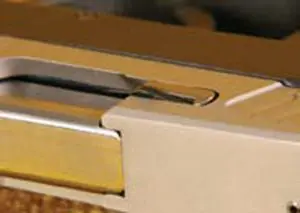
TCP SPECS
Given the pluses and minuses of a small gun, the TCP is actually a pretty impressive representative of the genre. It is a double-action-only, locked breech, modified Browning semiautomatic similar in size and appearance to the Ruger LCP and Kel-Tec P3AT.
The 3.25-inch long barrel is stainless steel with six lands and grooves, and integral to the barrel is the feed ramp, which is slightly polished to improve feeding.
The matte stainless steel slide is marked TCP, TAURUS and the Taurus logo on the left side, while the right side is marked PT 738 and .380 ACP. Deeply cut serrations at the rear provide good purchase for cycling the slide by hand. A blued version is also available.
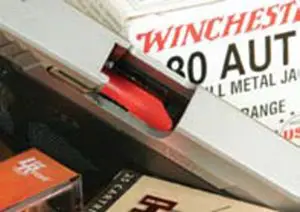
The fixed stainless front post and rear notch sights on the gun are small but adequate for close range work, as long as there is enough contrast between the light-colored sights and the target.
Like everything else on the TCP, the slide catch is small, but easily activated with the thumb. A small metal insert in the magazine follower engages the slide catch, which locks the slide back after the last round is fired to indicate that the gun is empty. That’s a nice feature. After reloading with a fresh magazine, the catch can be disengaged by the thumb of either hand if that is the user’s preferred way of charging the gun.
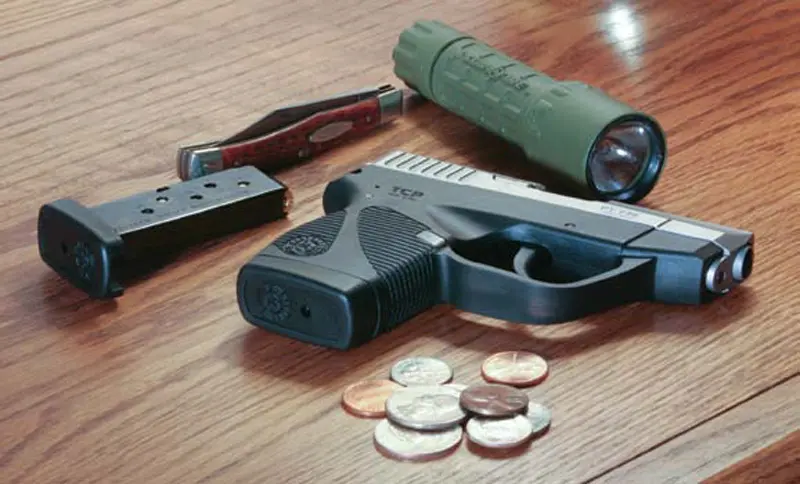
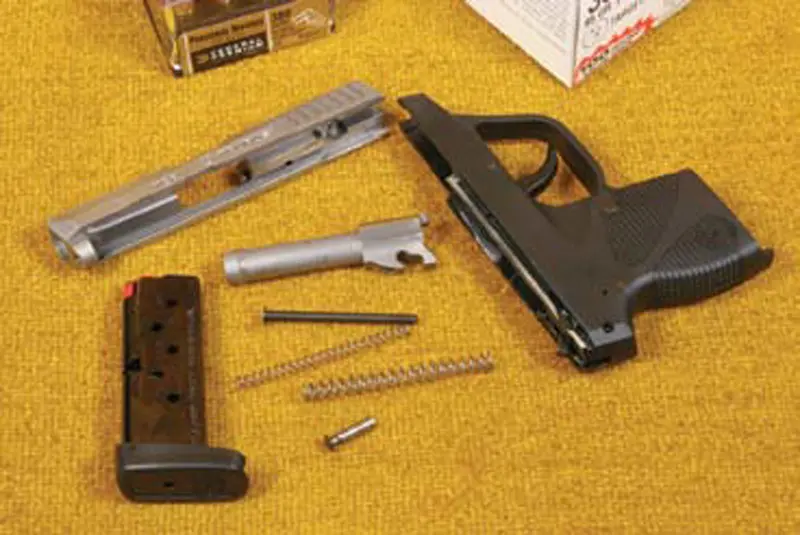
The frame is an aluminum block that resides within the polymer grip and provides mounting points for the fire control mechanism and rails on which the slide reciprocates. The steel ejector is also installed on the frame, while the stainless steel extractor is fitted to the slide. A blued steel loaded chamber indicator rides atop the extractor and, when a round is in the chamber, protrudes to provide visual and tactile notice that the gun is loaded.
The slide also houses the firing pin and its fairly strong spring. That heavy spring is probably one reason that the gun has no firing pin block safety. Another reason is that the internal hammer does not rest on the firing pin. The hammer is actually left in a partially cocked position by the rearward movement of the slide and strikes the pin only after the trigger is pulled. In this position, the hammer will not impact the firing pin if the gun is dropped. There is no external safety.
The trigger pull on the sample gun was very smooth, but long, letting off at five pounds with slight stacking just before let-off. The trigger has a pretty short reset, though, and is made of black polymer with a smooth rounded face. It’s not a bad trigger at all.
[Read Tom Givens Review of the Taurus Judge Gun]
The magazine release is located at the junction of the grip and the generously sized trigger guard—right where American shooters are used to finding it. It’s small and sits almost flush with the grip, but is still fairly easy to activate and allows the magazine to fall free when pressed. The steel, single-stack magazines have orange followers that indicate when magazines are empty and also have witness holes to allow a round count. The test gun was supplied with six-round magazines, but eight-round capacity magazines with extended floorplates are also available.
The magazine well is slightly beveled to aid reloads, although because the grip is short, speed reloads will require a great deal of practice and a lot of care so that the firing hand is not pinched. The floor plate of the magazine is about 3/8-inch thick and adds length to the grip, but only my middle and ring fingers found purchase on the gun.
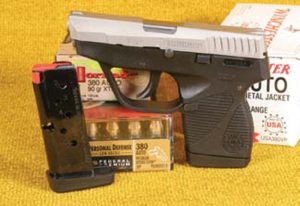
The grip is serrated all the way around, although a tight grip is still required to prevent slippage under recoil. There is a slight curve on the backstrap and the beavertail is deep enough to protect the web of the hand from the reciprocating slide. No sharp edges were noted on the test gun, and with the small sights and smooth lines, the gun is fairly snag free.
The Taurus TCP is easy to disassemble. After removing the magazine and clearing the gun, lock the slide to the rear with the slide catch. A screwdriver or other tool is needed to pry the retention pin, which Taurus calls the disassembly latch, from the left side, which then allows the slide assembly to be pushed forward and separated from the grip/frame assembly. Next, the guide rod and dual recoil springs that rest one inside the other can be removed. The barrel can then be separated from the slide. Assembly is in reverse order.
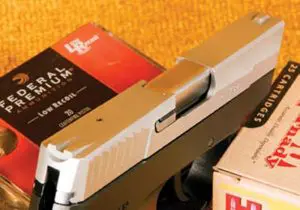
COMES WITH …
Besides two magazines, the gun comes with two keys for the Taurus Security System, which locks the action so the gun will not function. Some may like the lock and others may not. As Taurus wisely points out in the manual, “Securing your firearm may inhibit access to it in a defense situation and result in injury or death.” Life cannot be made risk-free.
The gun also comes with its own holster, but it doesn’t look like one. It’s from Bulldog and is made of nylon with magnetic catches on the flap and a clip to hook over the belt or waistband. It looks like a PDA or other electronic device holder and completely hides the gun. There are a couple of holes in the bottom that allow a finger to push the gun partially out so it can be grasped, but it’s not a lightning-fast draw system.
While the gun doesn’t come with one, Crimson Trace is developing a laser for the TCP. With its short sight radius and tiny sights, the laser would be an excellent addition to help make fast, accurate hits. But even the folks at Crimson Trace will tell you that you need to be able to use your iron sights, so practice with the TCP 738 would still be necessary.

RANGE TESTING
The TCP turned out to be a pretty good shooter. At the Scottsdale Gun Club’s indoor range and using an assortment of ammunition supplied by Winchester, Hornady and Federal, the gun printed groups averaging 1.5 to 1.75 inches at seven yards. This is a close defense firearm, so seven yards is a much more realistic range than the traditional 25-yard handgun standard. Bullets impacted at the point of aim, so the fixed iron sights turned out to be properly regulated.
Recoil was considerable, but neither uncontrollable nor uncomfortable.
Contrary to what some people think, writers don’t get special guns, and this particular gun had a problem. Of the two magazines supplied, one would not stay seated under recoil. Thinking that it might be the magazine, I requested two more, but they wouldn’t stay put either, so the entire gun went back to Taurus for evaluation and repair. In a short time, the gun was returned with a new grip, new magazine release and new magazine followers. The gun worked fine thereafter, so Taurus gets good marks for promptly fixing the problem.
The only other malfunctions encountered were early on in testing and consisted of two failures of the slide to lock back after the last round was fired, one failure to feed and one smoke stack. Since the malfunctions have not continued, I attribute them to a gun that needed to be broken in, which is not unusual.
The Taurus PT738 TCP is a very nice small, deep concealment pistol that will likely give the other major competitors a run for their money. The fact that the slide stays back after the last round is fired is an especially nice feature, and the price is pretty reasonable at $352.
